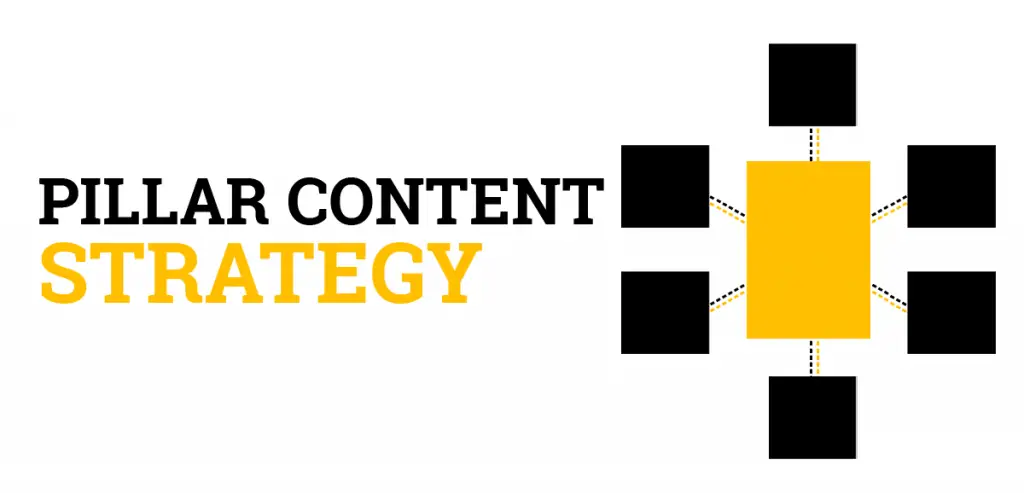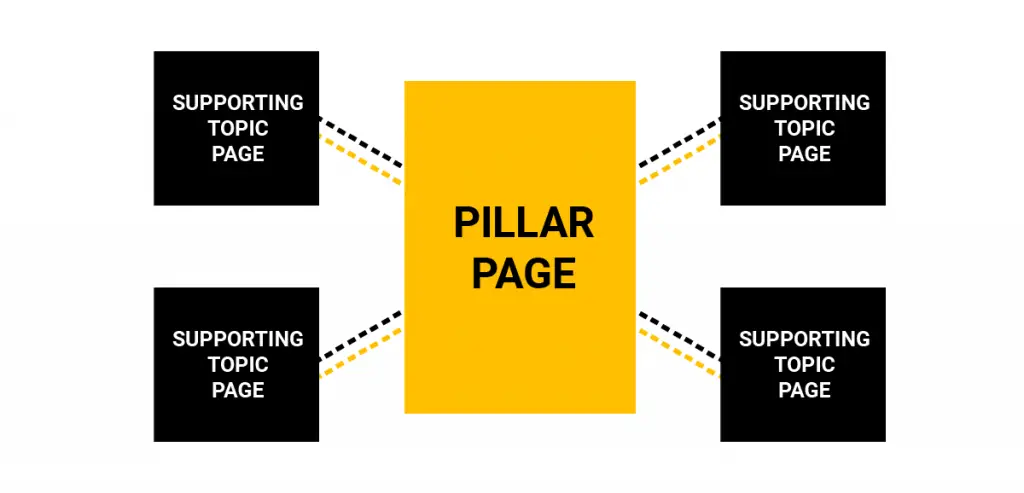When we create content for our sites, our end goal usually remains the same—more traffic and more conversions or revenue.
Sometimes this quest can feel like an uphill battle with no sign of success on the horizon.
If this sounds familiar to you, then you’ll probably want to add a good pillar content strategy to your bag of battle-tested tricks.
As you work on a content strategy for a new site or an existing site, focusing on topical authority should always be in the back of your mind. And using pillar content and topic clusters is the paint-by-numbers blueprint for success here.
In the last couple of years, I’ve seen tremendous growth on the sites in my portfolio where I have transitioned to a content strategy with pillar pages and topic clusters, also known as a pillar cluster content strategy.
In fact, one of my sites went from around 30,000 monthly traffic sessions to over 100,000 monthly sessions within 12 months of switching to this content strategy.
While I have an entire course on this very topic, below I’ll give you an overview of what you need to know on implementing this strategy for your sites.

What Is A Pillar Page?
Pillar pages are also known as a “hub” page, but the basics are the same, no matter what you want to call it.
Pick a high-level keyword or topic that you want to rank for, and then create an epic piece of content that serves as an overview or introduction to that topic.
A good example here is if you have a fitness site, then you could create a pillar page on “running for beginners.”
By design, a pillar page is a long piece of content. In fact, they can be really long. One of my favorite examples that I share with my students is the “How to Fly a Drone” page at UAV Coach. That one clocks in at almost 3,300 words.
Another great example that you’re likely already familiar with is Brian Dean’s “The Definitive Guide To SEO” article at Backlinko. That one is almost 4,500 words.
As you look at those two examples, you’ll notice that they have one thing in common – they link out to a lot of supporting content on the site.
Linking out to supporting content is a vital component of a pillar page.
As you create a pillar page, your intent should be to cover the topic well but not go in-depth on everything there is to know about it. Instead, you use that pillar page to link out to articles on your site to go in-depth on the finer details of the topic.
Using the example from above of running for beginners, you may have a section on your pillar page talking about the gear you need to run. Rather than having paragraphs on what you need broken down by season, style, or gender, you instead link to separate articles on each of those topics.
And as you create those supporting articles, you make a topic cluster, which builds the framework for a powerful pillar cluster content strategy.

Pillar Content Strategy Steps
Creating your pillar page and putting the strategy into practice takes a bit more planning than your average blog post because it’s not intended to be a standalone piece of content since it is part of a cluster.
1. Decide On Your Pillar Page Topic
The topic for your pillar page needs to be broad but not too broad. So instead of ‘running,’ you would focus on ‘running for beginners.’
It needs to be something you can create a few thousand words on while leaving enough remaining keywords to complete the supporting content.
2. Find What People Want To Know About This Topic
If you’re creating a pillar page on a topic you’re unfamiliar with, then you need to roll up your sleeves to do a bit of keyword research.
I ignore search volume for this and instead focus on finding the questions people ask about this topic. The People Also Ask section of the SERPs and the related searches at the bottom of the search results are a great place to find the keywords you’ll need as you create the outline for your pillar page.
Think of your pillar page as a broad overview of the topic. That means you don’t need to cover everything about it on the pillar page but instead hit the high points.
3. Get A List Together of Your Supporting Content Topics
As you create your pillar page, you’ll end up with a list of keywords on the subject. But the vast majority of those keywords won’t be used on your pillar page. Instead, those are the topics for your supporting content in the topic cluster.
Try to cover everything there is to know about the topic, from top to bottom. The end goal is to have content that brings in everyone, from people who are new to the subject to experienced people who may be on the hunt for a problem-solving article.
Remember, you are attempting to be the authority on the pillar page topic, and supporting content is how you do that.
For more details on this step, see this other guide on how to create a topic cluster content strategy.
4. Write Your Pillar Page
This step is pretty straightforward. After you’ve done the initial research for your pillar page, you then just have to write it. But remember, this page should have a long word count. So aim for 3,000 words or more.
You can find additional tips on how to write SEO friendly content here so the pillar page is well-optimized for the search engines to rank for its target keywords.
5. Create Your Supporting Pages and Internal Links
After your pillar page is published, the final step is to create your supporting topic pages.
These can be as few as 500 to 800 words or even up to 2,000 words more.
Just write as much as the topic requires for the reader without worrying too much about the word count here.
Now the real trick for this step to create a killer pillar content strategy is to use these supporting topic pages to link internally to the pillar page with keyword-rich anchor text.
This helps boost relevance and authority for the keywords you want the pillar page to rank for.
But don’t just use the same keyword over and over again 100% of the time for your internal links. Mix it up with exact matches and keyword variations so you don’t become too overoptimized.
You also want to link from your pillar page to these supporting topic pages. The best results come from linking from the pillar content to the most important supporting articles. Then all supporting articles link back to the pillar page.
Topic Clusters 101
Topic clusters are a collection of closely related articles designed to support that pillar page you’ve created. Sometimes, supporting content is called “spokes” as part of the “hub and spokes” model, which is another name for pillar pages and topic clusters.
When done correctly, a topic cluster helps a low (or lower) authority site beat those mega authority sites in the SERPs.
How does this happen? Witchcraft.
Okay, not really. It’s actually just topical authority.
Google goes bananas for topical authority, which is why it should be your #1 focus as a content creator and site owner.
But like I mentioned above, you have to create your topic clusters the right way for the magic to happen. Luckily, this is a super easy thing to get right.
- Each supporting article should link back to the pillar page
Yeah, that’s really the main thing you have to do – make sure that you link to the pillar of your cluster from each of the supporting articles in the cluster.
How many supporting articles do you need in each cluster? That varies by cluster.
The broader the topic of your cluster and pillar page, the more supporting content you’ll be able to create.
For example, a pillar page for ‘running for beginners’ will have more supporting content than a pillar page for ‘how to buy running shoes.’
Benefits Of A Pillar And Cluster Strategy
As mentioned above, focusing on pillar pages and topic clusters gives your site insane topical authority, which helps you rank for seemingly impossible keywords.
But that’s not the only benefit you’ll see once you start doing this.
Better Discoverability
We should all be striving to keep visitors on our sites for longer. And when you have a silo, instead of a topic cluster, on your site, it is more difficult for visitors to find content relevant to their interests and needs.
Simply having all of your running content under the category ‘running,’ which is linked in your navigation bar, isn’t a great user experience for site visitors. There’s no clear structure or way for visitors to know you cover the topics they seek out.
But with topic clusters, all of that internal linking within the cluster makes it easy for site visitors to navigate through that cluster and get the info they need.
This means they stay on your site longer and are more likely to return to your site when they have a question or a problem on the same topic.
Natural Links Magically Appear
Since pillar pages are typically epic pieces of content, you often have the best article on the topic. And that means people are more likely to link to that pillar page naturally.
If you hate link building as much as I do, then you may find this the best part of creating pillar pages.
In my experience, your pillar pages can score links from high authority sites like newspapers, which are hard for your competition to replicate since they can only be earned and not bought.
Established Credibility
Since topic clusters give your site a lot of content on a specific topic, you end up with this sort of natural credibility on the subject.
This is part of that whole topical authority thing that Google loves. Create a ton of related content on X topic, and you (and your site) are suddenly seen as an expert on X topic.
In addition to the benefits you’ll see in the SERPs as an authority on the topic, you can also end up with some fantastic opportunities like being contacted by local or national media for interviews and quotes.
This also naturally leads to more revenue opportunities for you as you can create books and other info products on the topic as an established expert. You could even end up with a legit book deal if that’s one of your goals.
Putting Your Pillar Content Strategy Into Practice
Once you’re ready to overhaul your content strategy to focus on pillar pages and topic clusters, you’ll need to prepare yourself for the hard labor.
The content. Lots and lots of content.
Creating quality topic clusters with epic pillar pages takes a lot of work.
Quality should be high on your priority list here; otherwise, you’re going to be putting in all of this work for nothing.
And the key transition in your mindset will be when you’re doing keyword research for your pillar content strategy. Instead of asking yourself, “what can I rank for?” you have to think, “what do I want to rank for?” as you make your content plan.
Contributing Author: Shawna Newman
Shawna has been building and flipping sites since 2008. She shares updates on her website portfolio and SEO experiments at Skipblast.com.


SEO Chatter is dedicated to teaching the fundamentals of search engine marketing to help marketers understand how to increase organic website traffic and improve search engine rankings.
